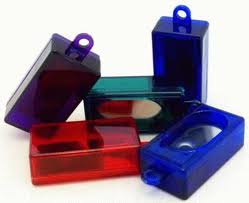Congratulations on your decision to use TAGteach to increase functional behaviors in your child with autism. Here are some suggestions for how to get started. Once you have tagged your child a few times, you will find it easy and natural to do.
We are frequently asked how much background and explanation is needed before getting started with tagging. The answer is: as little as possible. Just jump right in and start tagging! Your child will figure out very quickly that the tag is followed by a treat and that his actions are causing you to tag. This gives your child an unprecedented degree of control and he will be excited to play the game. If your child needs some explanation, just use as few words as possible to explain that the tag sounds means he did something right and he will get a treat after each tag.
1. Gather your materials: A tagger and reinforcers
 A TAGteach tagger is a small plastic box clicker; available here. You can use any object that makes a quick, sharp click sound: a ballpoint pen, a flashlight, or if need be, a spoon to tap.
A TAGteach tagger is a small plastic box clicker; available here. You can use any object that makes a quick, sharp click sound: a ballpoint pen, a flashlight, or if need be, a spoon to tap.
Reinforcers are any items that your child values. Get some treats that your child likes: very small pieces of candy, pretzel pieces, cereal pieces, tic-tacs, or anything similar. Put them into a small container that you can hold in your hand. A desired item can by anything: candies, treats, a chance to play with a toy, tokens for special treats or privileges, or money; social praise or recognition can sometimes serve as a reinforcer.
For more ideas about reinforcers, do a Google search on “reinforcers for autism”. The key point with a reinforcer is that it must be something the child likes and will work for. The easiest way to start is with food or drink – so unless this is impossible, we suggest that you use an edible treat for your first attempts at TAGteach.
2. Think about what you want
Each child with autism has a unique profile of skills, sensory issues and behaviors. Each family has a unique combination of people, responsibilities and resources. Take a few minutes to think about your priorities:
What issues are at the top of your mind right now?
What functional skills or behaviors would help your child with autism, and/or help your family situation?
Take a few moments to jot these down. Be sure to write these in positive terms so that they are statements of what you want your child to DO (as opposed to what you want to stop or prevent).

